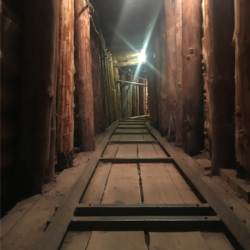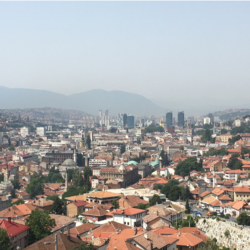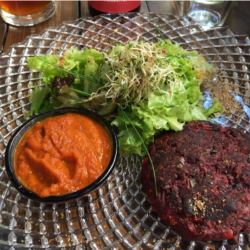
Despite the horrors and hardships Sarajevo suffered during the 1990’s and fully admitting that the ghosts of those events are still living very close to the surface in minds of many citizens, Bosnia and Herzegovina’s capital today is a bastion of hope, warmth and vibrancy. Nowhere is this more apparent than in the Baščaršija (Old Turkish Quarter) where you can walk five blocks and run into a mosque, synagogue and Catholic and Orthodox churches. (Fun fact: Sarajevo is long, skinny city, stretching east to west in a valley. If you start walking west from the Baščaršija, you will see the city morph from Ottoman baths and bazaars to Austro-Hungarian architecture, followed by massive Soviet-style government buildings and finally enter into the modern financial center of glass skyscrapers. The city itself acts as a living museum as you follow its evolutionary timeline.)
Back to the Baščaršija: Sarajevo would not be what it is today without the Waqf or endowment made by Gazi Husrev-beg, the Ottoman ruler of Bosnia from 1521-1541. As I understand it, in Islamic law, a Waqf is land and property given to the community without any expectation of profit or repayment in return. Basically, Gazi Husrev-beg willed everything he had to the city, allowing it to flourish. His Waqf included the mosque named after him, several schools, a library, soup kitchen, hotels, public baths, the first public toilet, and a marketplace area. He essentially laid the foundation for what still remains of the Baščaršija. You can get an in-depth look into this leader at the Gazi Husrev-begov muzej (museum), which is where I started my religious tour of the city.

The Kuršumlija medresa, an educational complex which houses the museum, was built in 1537. Right next door is the Gazi Husrev-begova hanikah, which houses an art gallery.

Some students and artists attempted to petition the city for control of the former barracks, but failed. In 1993 they decided to just start squatting in the buildings and they have been there ever since. They are connected to city utilities like power and water, which are paid for by the profits from bars and art galleries in the commune, but otherwise they pay no taxes or rent on the buildings and are able to serve liquor without a license. Rather than fighting the art colony, Ljubljana named Metelkova a “national cultural heritage site” in 2006, which afforded it several protections.

Across the way from museum is the beautiful Gazi Husrev-begova džamija (mosque), the largest mosque in all of Bosnia and Herzegovina. The mosque was built in 1532 and has been destroyed and rebuilt several times. It was greatly damaged during the Siege of Sarajevo in the mid-90’s, but has since undergone a major restoration project. The mosque allows visitors during certain hours; make sure you wear respectable clothing and take your shoes off before entering. I found the courtyard and mosque to be an oasis of serenity and peacefulness in the otherwise bustling Baščaršija. The centerpiece of the courtyard is a fountain where people gather to wash their hands and feet.



Moving west from the mosque you will come across the small Jewish quarter of the Baščaršija, the highlight of which is the Muzej Jevreja Bosne i Hercegovine (Museum of the Jews of Bosnia and Herzegovina). The museum is housed in the Old Synagogue and has exhibits on Jewish life in Ottoman and Bosnian Jews who died in the Holocaust. The staff was very friendly, ready to answer any question and dole out additional tidbits about the synagogue.


Continuing west from the synagogue is the Katedrala Scra Isusova (Sacred Heart Cathedral), which was consecrated in 1889 and is the largest cathedral in Bosnia and Herzegovina. Pope John Paul II visited Sarajevo in 1997 after the Siege; the Pope was a great promoter of peace during the war and in 2014 a statue was erected to honor him in front of the cathedral.

Around the corner from the Catholic cathedral is the Saborna Crkva Rodenja Presvete Bogorodice (Cathedral Church of the Nativity of the Theotokos), an Orthodox cathedral, which is stunningly lit at night. This outpost of the Serbian Orthodox Church was constructed during the 1860’s and was the first major non-Muslim building to pierce the Sarajevo skyline. (The Old Synagogue had been around since the 16th Century, but its height never rivaled that of the Gazi Husrev-begova džamija and therefore didn’t incite the same controversy the high domes of the Cathedral did with certain conservative Muslims.)

Whatever conflicts, be they religious, ethnic or political, that had arisen in the past, I view all these current religious institutions co-existing within a stone’s throw of one another as a symbol of what the world should be striving for today. The past cannot and should not be forgotten, but as each year passes the once tenuous net of peace that enshrines the city appears to only be growing stronger and stronger.


